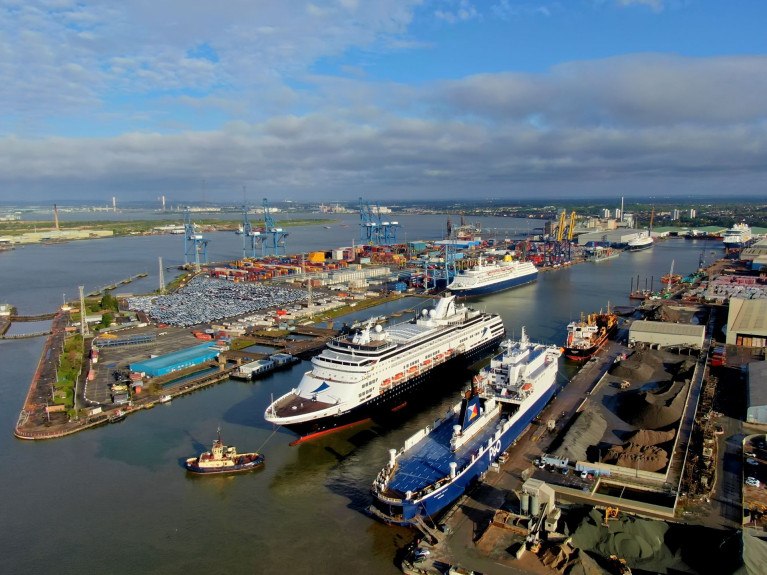Displaying items by tag: Cancelled calls
Cancelled Cruiseships for Dun Laoghaire Include 'List' of Detained CMV Ship But Not Irish Serving Fleetmate
On this date next month a cruiseship due to call to Dun Laoghaire Harbour however remains on the harbour's website list of callers despite the collapse of the ship's cruise-operator CMV, writes Jehan Ashmore
Noting in addition the Government's ban on cruise ships calling to Irish ports as part of Covid-19 travel restrictions which affected this year's Dun Laoghaire Harbour season dramatically with cancelled cruise calls (list here) is all too apparent and likewise nationwide, see: 'Cruise Industry in Ireland will not recover until 2023'.
Next month the 1,626 passenger Vasco da Gama was scheduled on 21 September with a debut call to the south Dublin Bay harbour operated by Dun Laoghaire-Rathdown County Council. This visit however cannot take place given the cruiseship's operator, Cruise & Maritime Voyages (CMV) went into administration in June following the severe impact caused by the Covid-19 lock-down on the global industry.
In addition to Vasco da Gama (see photo) other fleetmates have come and gone in Tilbury Docks, London where Magellen (which Irish 'homeported' of recent years out of Dublin and Cork) is a more recent caller to the dock on the Thames estuary. It was here that the Maritime Coastguard Agency however found five deficiencies with three grounds for detention in the case of Vaco da Gama and fleetmates in June according to the UK agency's website though with exception of Magellan.
In addition to CMV unable to make a debut off Dun Laoghaire Harbour, firstly in June, the list includes five 'turnaround' calls. One of which would of involved an overnight port of call by the Crystal Symphony, albeit requiring the Crystal Cruises ship to make an anchorage call in Dublin Bay.
Vasco da Gama was among the more recent secondhand tonnage to join CMV following a career that began as Statendam, leadship of Holland America Line (HAL) quartet of the S class series.
Statendam was transferred to P&O Cruises Australia and renamed Pacific Eden before returning to the northern hemisphere with CMV deploying the ship on cruises to include Dublin Port last year where footage of the handsome looking vessel can be seen from footage on You-Tube here.
Unlike this ship, some of the CMV fleet this season sported a new 'all blue livery' scheme for this year which marked the 10th anniversary of CMV's establishment which expanded by offering mostly the UK market cruisegoers conveniently embarking in regional ports. Whereas, CMV in Ireland provided holidaymakers direct cruises served out of Dublin and Cork (Cobh) through Magellan and not CMV's first cruiseship Marco Polo concentrating on UK cruisegoers.
In addition a second cruise ship remains on the Dun Laoghaire Harbour list but not 'cancelled' in regards to Sea Cloud II, an impressive Maltese flagged sail-powered cruiseship which was due to have made a maiden call to the Irish port earlier this month.
The visit of Sea Cloud II would of involved an overnight turnaround cruise with clientele from the high-end of the luxury cruise market. A demonstration of this particular luxurious market is that the tallship's operator, Sea Cloud Cruises have a crew of 65 personnel to serve guests shy of only 100 on the Spanish built 'windjammer' which entered service in 2000. Sadly this opportunity has gone to make such an inaugural call.
As for the final end of season cruise caller this was scheduled to take place in early October as one of the turnaround callers. In this case the brand new boutique megayacht like ship, World Explorer was also cancelled.
High Winds Cause Cruiseships to Cancel Calls During High Season
High winds played there part in determining cruiseship destinations among visiting vessels that were scheduled to call to Irish and Welsh ports, writes Jehan Ashmore.
Most recently to become subject to the conditions involved Princess Cruises smallest ship, the 670 capacity Pacific Princess which was unable yesterday to anchor safely offshore of Milford Haven in south Wales.
The Bermuda flagged cruiseship continued a passage to Dublin Port and where the 30,000 gross tonnage vessel arrived today. A fleetmate, Crown Princess is also today visiting the Irish capital but unlike the 'Pacific' is to remain in port overnight.
The cancelled call by Pacific Princess to the port in Pembrokeshire had prematurely ended a season which saw three ships visiting. Silverseas Silver Cloud called twice, once in May and June and Hapag Lloyd's Europa made an appearance last month.
A Silverseas fleetmate the 294 guest capacity Silver Wind was the other aptly named cruiseship affected by such weather conditions but which took place in Irish waters.
Silver Wind had arrived in Galway Bay in the early morning of last Friday and sheltered in the lee of Black Head, Co. Clare. Due to the prevailing winds, tenders could not take guests ashore to the Port of Galway forcing the 17,400 gross tonnage vessel to cancel the call.
Instead the Bahamas flagged Silver Wind proceeded to Lisahally (Foyleport) followed by Greenock, Scotland. By coincidence, Silver Wind is today also docked in Dublin Port having previously called to Belfast Harbour.
Despite the cancellation to the Port of Galway a further four cruiseships is scheduled with Fred. Olsen Lines Black Watch ending the season early next month.
























































